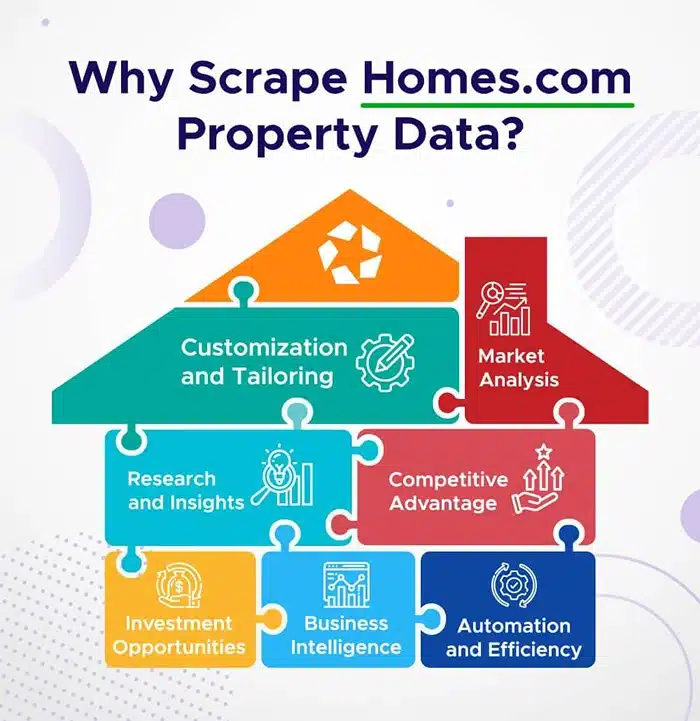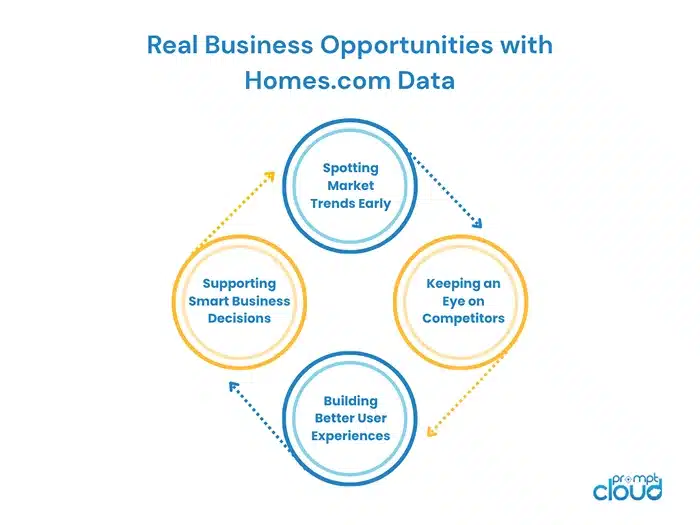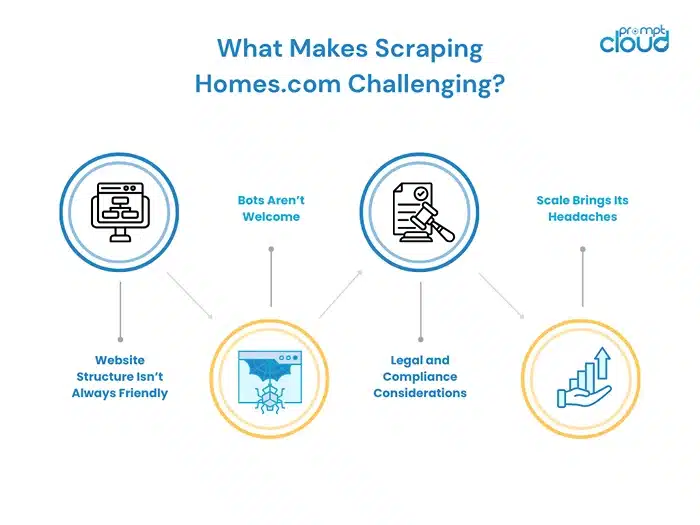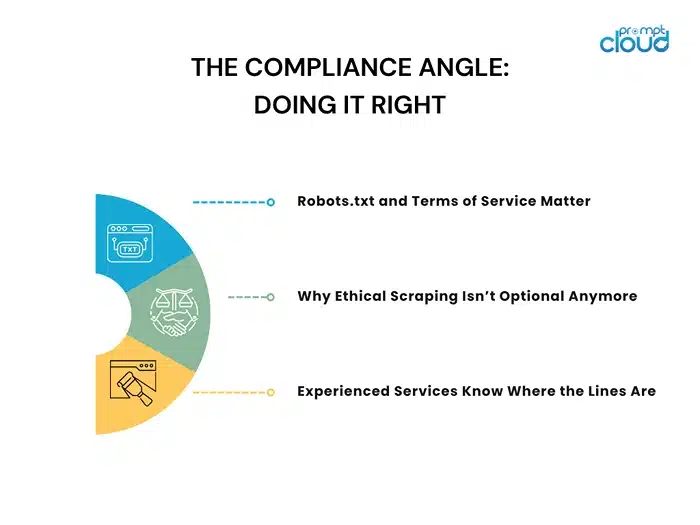
**TL;DR** A lot of people in real estate talk about Zillow and Redfin when it comes to data, but Homes.com has quietly become a pretty useful source, too. There’s a ton of property info on the site, prices, photos, agent details, neighbourhoods, you name it. Getting that data in a usable format, though, isn’t always easy. The site has a few technical roadblocks, and if you’re not careful, you could run into some compliance issues, too. That’s why many teams are turning to web scraping services that can do it the right way. It’s faster, more reliable, and saves you a lot of headaches.
The Rise of Real Estate Intelligence

Image Source: jellyfishtechnologies
You’ve probably noticed, real estate isn’t what it used to be. A lot has changed over the past several years. It’s not just about flyers, local agents, or driving around looking for “For Sale” signs anymore. These days, people go online first. That’s where their home search starts. They browse, compare, and bookmark listings. And behind all that? It’s data. Loads of it. Listing prices, neighborhood stats, photos, schools nearby—it’s all shaping how folks decide where to live. A lot of it. From listing prices to nearby schools and market trends, everything they need is just a few clicks away.
This shift has put websites like Homes.com in a very important spot. With millions of listings and detailed property information, it’s become more than just a place to browse homes. For many real estate professionals and PropTech companies, it’s a rich source of real estate data that can power smarter decisions, better products, and stronger customer experiences.
That said, having the data is one thing. Getting it in a clean, structured, and reliable format is another. Most websites, including Homes.com, aren’t designed to easily give away their data, especially at scale. That’s where the idea of scraping Homes.com comes in.
Scraping Homes.com—or any big real estate site—isn’t just a matter of pulling down some listings and calling it a day. It gets more complicated quickly. You’ve got to figure out how the site’s built, like where the actual data sits on the page and whether it loads normally or through scripts. Then there’s the issue of getting blocked if you make too many requests too fast, or if the system thinks you’re a bot. And yeah, there’s also the legal side—you’ve got to be sure you’re not violating the site’s terms of use. That’s why a lot of data teams don’t do this in-house. They just bring in a scraping service that already knows how to handle all that.
In this article, we’ll break down why Homes.com scraping is worth your attention, what kind of opportunities it unlocks, the common roadblocks you might hit, and how services like PromptCloud help companies extract data the smart way—at scale, and within the rules.
Why Scrape Data from Homes.com?

Image Source: Crawlbase
When people think of online real estate platforms, Zillow and Redfin usually come to mind first. But in recent years, Homes.com has quietly become a serious player. It’s not just growing fast, it’s backed by CoStar, a major name in real estate. And with millions of listings and users visiting every month, it’s starting to matter a lot more to businesses that work with property data.
So why are more companies looking into scraping Homes.com?
Homes.com Offers a Lot More Than You Might Think
Most real estate sites list homes for sale — that’s a given. But Homes.com does more than just show listings. Each property page can include:
- Pricing, square footage, number of rooms, and how long the home has been on the market
- Big photo galleries, sometimes even 3D tours
- Local information like nearby schools, traffic, and even how walkable a neighborhood is
- Contact info for real estate agents connected to that listing
- Notes about price changes and the property’s sales history
All of this might seem like standard stuff on the surface, but when you gather and organize it at scale, it becomes valuable. It can feed into pricing tools, market trend reports, neighborhood ranking features—you name it.
It’s a Strong Addition to Zillow and Redfin
Even if you’re already pulling data from other platforms, Homes.com still adds value. Not every listing shows up on every site. Sometimes details are missing or formatted differently across platforms. By including Homes.com in your data pipeline, you fill in those gaps and catch things you might’ve missed.
Say you’re building a product that shows homebuyers which listings are most likely to sell quickly. That model gets a lot better if it’s trained on data from multiple sources, not just one.
There’s More to It Than Just Listings
Scraping data from Homes.com doesn’t just help with showing homes on a map. Real estate companies are using this data in lots of smart ways.
Some use it to figure out which neighborhoods are heating up, based on listing activity and price changes. Others track agent performance by analyzing how often someone shows up with listings or sales. Some of these newer PropTech tools? They’re not just about what someone can afford. They’re trying to match people with homes that fit how they live, their routines, preferences, all that.
The common thread? They all need fresh, structured data, and Homes.com has plenty of it.
Real Business Opportunities with Homes.com Data
There’s a lot of talk around “real estate data” these days, but most of it sounds the same. Everyone wants better data, smarter tools, and some edge in a crowded market. But not everyone’s looking in the right places. Homes.com? That’s one of those places people tend to overlook, even though it’s quietly packed with useful info.
Here’s how teams are using it.

Spotting Market Trends Early
The housing market doesn’t send out alerts when something shifts. It just moves. In one week, homes in a certain neighborhood sit for 20 days. A few weeks later? They’re gone in 5. Stuff like that shows up in the data long before you read about it in the news.
When you’re pulling data regularly from Homes.com, patterns start to show up. Maybe sellers are dropping prices faster in one area. Or listings are staying live longer in another. None of this comes from gut feeling—it’s right there in the numbers if you’re paying attention. That’s where scraping helps. It lets you track things quietly and build your own take on where things are headed.
Keeping an Eye on Competitors
Let’s not pretend people aren’t watching each other. If you’re running a real estate business, of course, you’re checking what the other guys are doing. That’s just part of the game.
With data from Homes.com, you can see which agents are posting the most listings, who’s entering your market, or what price points are getting the most traction. It’s not always about copying—it’s about staying aware. Sometimes you see a trend first. Sometimes you see someone else move, and it forces you to ask, “Should we be doing that too?”
Scraping makes it easier to track all that without digging through pages manually.
Building Better User Experiences
People don’t just want property listings. They want listings that feel right for them. That means your app or product needs to be smarter than just showing “3-bed, 2-bath, under 500K.”
Homes.com data can help with that. You get photos, agent details, neighborhood data, and more. With enough of it, you can start building features that learn what users care about. Not just filters, but recommendations that adapt—stuff that feels personal.
It’s the kind of thing that’s hard to pull off if you’re just relying on one source. Homes.com adds more texture to your dataset, and that helps your product feel less generic.
Supporting Smart Business Decisions
Sometimes it’s not about fancy features. Sometimes you just need to know where to spend money or where to send people. Homes.com scraping can help with that, too.
Let’s say you’re looking to open a new office or invest in a neighborhood. If you’ve been collecting data over time, you can look back and see where listings are heating up. Or where things are slowing down. It’s not guesswork anymore. You’ve got numbers to back it.
Same goes for pricing. Want to know if you’re off the mark? Compare your listings to what’s showing up on Homes.com. It won’t give you all the answers, but it gives you a better place to start.
What Makes Scraping Homes.com Challenging?
Scraping a site like Homes.com might seem easy at first glance. You open the site, see listings, and it feels like all the data is just sitting there. But once you try pulling it at scale—or even just consistently, you start running into all kinds of issues you probably didn’t plan for.

Website Structure Isn’t Always Friendly
You pull up the site, and at first glance, it all looks normal. Listings are there, images load, and everything seems straightforward. But once you dig into the code or try to grab the data, you start to notice—it’s not just plain text sitting on the page. A bunch of it only shows up after the page finishes loading. It’s pulled in through background scripts, which makes things a bit harder if you’re trying to scrape it cleanly. That means a regular scraper might miss it completely.
Also, pages are linked in ways that aren’t always predictable. One listing might lead you straight to what you need, and another takes three extra clicks. You kind of have to build logic just to get from A to B, and it changes more often than you’d think.
Bots Aren’t Welcome
This is a big one. Homes.com, like most real estate platforms, doesn’t exactly roll out the red carpet for scrapers. They want real people using the site, not automated systems. So, if your scraper starts pinging the server too fast or looks like a bot, it might get blocked. Sometimes, you’ll get a CAPTCHA. Other times, nothing loads. It just stops working without much of an explanation.
And the tricky part? You might not even know you’ve been blocked right away. The scraper just keeps going, collecting empty data.
Legal and Compliance Considerations
Now this part trips people up. Is scraping legal? The answer is… sometimes. It depends. You’re pulling public info, sure, but that doesn’t mean it’s free game. Homes.com has a terms of use page that most people don’t read—but should. There are also rules written into the robots.txt file that some teams don’t even look at.
If you ignore that stuff, it’s not just risky—it can get you into actual trouble. Even if your intention is clean, the method matters.
Scale Brings Its Headaches
Pulling data from ten pages? Fine. A hundred? Still doable. But once you’re looking at thousands—or want to update that data every single day—that’s when it starts to break. One little change to the site’s layout and suddenly, nothing works. Now you’ve got to fix it, re-test, re-deploy, all while your pipeline is paused.
It becomes a job, honestly. Not just a task. It needs care, logs, backups, retries—all the things you might not have thought about when you first wrote a quick script.
How Web Scraping Services Solve These Challenges
So, let’s say you’ve tried scraping Homes.com on your own—or at least thought about it—and now you’re hitting some walls. Maybe your scraper keeps breaking, or maybe it’s running slow. Or maybe it’s working… but you’re just not sure if you’re doing it right, legally speaking. That’s where a web scraping service makes sense.
This isn’t just about outsourcing a task. It’s about handing over a problem that someone else already knows how to solve—and has solved a hundred times before.
Custom Scrapers vs. Full-Service Solutions
Some teams try to build their own tools. And that works… up to a point. If you’ve got a small project or you just need to grab data once, a custom script might get you by. But when the volume grows—or the site changes structure (which it will)—that custom tool turns into a full-time headache.
A scraping service, on the other hand, handles the whole pipeline. Not just the extraction, but also cleaning the data, formatting it, dealing with blockers, and keeping it all running day after day. You don’t have to worry if the site adds a new layout tomorrow. That’s handled.
How PromptCloud Handles Homes.com Scraping
At PromptCloud, we’ve worked with all sorts of real estate platforms. Homes.com is familiar territory for us. We’ve already dealt with its structure, its protections, and all the curveballs that come with scraping it at scale.
What we offer isn’t just a script, it’s an ongoing system. We crawl the site responsibly, clean the data, remove duplicates, map it into structured formats, and deliver it the way you want—via API, in a file, or even pushed straight to your database. You don’t have to chase updates. You just get the data, ready to use.
And it’s not one-size-fits-all either. Some clients want just listings. Some folks are after more than just listings. They might want to dig into agent info, or maybe they’re tracking price history across a few zip codes. We usually just talk through what they need, then shape the extraction around that—nothing cookie-cutter.
Compliance, Quality, and Long-Term Stability
One thing we never overlook: doing this the right way. Pulling data from a busy site like Homes.com isn’t something you want to rush or do carelessly. We take our time with it. That means following the site’s pacing rules, keeping an eye out for any layout or structure changes, and just making sure our crawlers behave—nothing pushy or spammy.
And beyond the tech part, we think about the legal side too. We don’t go in blind. We evaluate the site’s terms, use ethical scraping methods, and build long-term relationships with clients who care about compliance just as much as we do.
Because let’s face it—no one wants data that was gathered recklessly. If it’s going to power your business, it needs to be solid, clean, and collected responsibly.
A Closer Look: Homes.com vs Zillow and Redfin
If you’ve been in real estate for more than a minute, you’ve probably worked with data from Zillow or Redfin. Those two have been the go-to sources for years. And for good reason, they’ve got tons of listings, strong brand names, and lots of tools for users.
But here’s the thing: Homes.com is starting to catch up, and in a few ways, it’s doing things differently. Depending on what kind of data you need, it might even be a better source for you.
Data Differences That Matter
Let’s talk about listings first. You might assume that most properties show up on all three sites. But in reality, that’s not always the case. Some agents prefer one platform over another, or syndicate through different MLS systems. So, Homes.com ends up with listings that you won’t always find on Zillow or Redfin.
Also, the way listings are structured is different. You’ll sometimes see stuff on Homes.com that just… doesn’t show up the same way elsewhere. Like, agents might write their own notes, or upload newer photos, or there’ll be extra info about the neighbourhood. It’s not always a huge deal when you’re looking at one listing, but once you start pulling a lot of them. Those little things can make a big difference in how useful the data is.
For example, if you’re building a tool that shows property price movement over time, missing even 10% of listings can throw things off. Homes.com helps close that gap.
Positioning in the Real Estate Ecosystem
Zillow is a giant, and Redfin’s carved out its niche with map-based searches and its own brokerage model. Homes.com? It’s taken a slightly different route. Since being acquired by CoStar, it’s been revamped to act more like a data-forward listing engine. That means more focus on accurate listing info, verified agent contact details, and neighborhood data.
It’s also being positioned as a platform that’s friendlier to agents, which has led to better cooperation in terms of up-to-date data. For data teams, that’s a big plus. You want sources that are maintained, complete, and accurate.
And if you’re in PropTech, having Homes.com in your data stack isn’t just a nice-to-have—it gives you visibility into a slice of the market that might be missing from other sources.
Why Homes.com Is Still Underused
One interesting thing? Even though Homes.com gets over 20 million monthly visitors, a lot of data teams aren’t scraping it yet. Everyone’s focused on Zillow or Redfin, which creates an opportunity. If you’re one of the few pulling structured data from Homes.com consistently, you’re seeing things your competitors might not.
That alone can be a real advantage, especially in analytics-driven businesses, where a little more data can mean better forecasts, smarter pricing, and sharper customer recommendations.
The Compliance Angle: Doing it Right
Okay, so here’s where things get real. Scraping data from websites like Homes.com can be super useful—but only if you’re doing it the right way. Otherwise, you’re opening the door to problems that can get expensive fast. Legal problems, reputation issues, and even having your IPs blacklisted. Not fun.
That’s why any serious real estate team or PropTech company needs to think about compliance from the start, not as an afterthought once the data’s already in your system.

Robots.txt and Terms of Service Matter
It’s tempting to ignore those little files tucked away at the root of a site. You know the ones, robots.txt and pages full of legal text. But here’s the deal: they set the rules. Robots.txt tells crawlers what they can and can’t access. And while it’s not a law, it’s seen as a baseline for ethical scraping.
Then there’s the Terms of Service (ToS). These vary from site to site, but some platforms are very clear that scraping without permission isn’t allowed. Others are vague. Either way, if you don’t read it—and respect it—you’re running blind.
And if you’re working at a company, not just hacking around on a side project, you’re putting your brand at risk by not taking this stuff seriously.
Why Ethical Scraping Isn’t Optional Anymore
Look, scraping used to be kind of the Wild West. People wrote scripts, pulled data, and hoped for the best. But the internet’s changed. Big platforms have legal teams. Scraping lawsuits have happened. You don’t want to be in one.
Today, ethical scraping isn’t just a buzzword. It’s how responsible companies work. That means you:
- Respect crawl-delay instructions
- Avoid overloading servers with aggressive scraping
- Monitor changes in the site’s policies
- And most importantly, avoid collecting anything that’s behind a login or not meant to be public
Following these basics shows you’re not trying to exploit the system—you’re just trying to collect data that’s already out there in a respectful way.
Experienced Services Know Where the Lines Are
This is exactly where working with a web scraping service like PromptCloud helps. We’ve been doing this for over a decade, and one of the first things we do with any new site is evaluate compliance risk. We check the robots.txt. We read the ToS. We built a crawler that plays by the rules.
And if the site structure changes, or if a client’s needs evolve, we adjust the setup without ever crossing ethical lines. You don’t need to babysit the legal side or worry about how the data is being collected. We keep everything above board so your team can focus on what matters: using the data.
PromptCloud’s Approach to Scraping Homes.com
At this point, you might be thinking: “Alright, scraping Homes.com sounds useful, but we don’t have the time or resources to build and manage this in-house.” That’s exactly where we come in.
At PromptCloud, scraping data isn’t just a service we offer—it’s our core business. And real estate? That’s one of the spaces we know best. We’ve worked with plenty of clients who needed listing data, agent profiles, pricing history—you name it—from platforms like Zillow, Redfin, and yes, Homes.com too.
So, what does working with us look like?
It Starts with What You Need
We don’t offer cookie-cutter scrapers or off-the-shelf tools. That’s not how good data pipelines work. Instead, we start by asking what exactly you’re trying to get from Homes.com. Is it just property listings? Are you tracking price changes? Do you need agent-level activity or market coverage by city?
Once we understand your use case, we build a custom scraping setup around that. You get the fields you want, in the format you need, delivered on the schedule that works best for you, daily, weekly, whatever fits.
And you don’t have to lift a finger. We handle the whole thing behind the scenes.
Our Pipeline Handles the Tough Stuff
Scraping at scale brings a bunch of challenges—timeouts, site changes, duplicate entries, occasional errors. Our system handles all of that. We monitor things constantly, update crawler logic when site structures change, and make sure the data you get is clean and usable.
We also offer options for delivery. Want it pushed directly into your S3 bucket or database? Done. Prefer a secure API? No problem. CSV files via email? Still fine. We adapt to how your team works, not the other way around.
Built for Compliance, From Day One
We’ve said this before, but it’s worth repeating: we don’t cut corners. Homes.com, like every other major site, has its own rules. We follow them. Every crawl is set up to respect rate limits, avoid unnecessary server load, and stay within ethical scraping practices.
And we don’t just set it and forget it. If there’s a change in the site’s policies or layout, we’ll flag it. We believe our job is not just to deliver data, it’s to protect your business while doing it.
Tracking Listings in Growth Markets
One of our clients, an analytics firm focused on residential investing, wanted to track how property prices were moving in fast-growing suburbs across the U.S. They needed data from multiple sources, and Homes.com was one of them.
We built a multi-source pipeline that pulled listings across dozens of cities, normalized the fields (since each site labels things differently), and delivered it all in one clean feed. The client used that to build pricing models, find emerging trends, and help their users pick investment spots before they got too hot.
And the best part? They didn’t have to maintain any of it. We kept everything running smoothly in the background.
Unlocking the Value of Homes.com Data
So here’s where it all lands: Homes.com is no longer just another listing site. It’s become a solid, growing platform with real data that real estate companies can use to make better decisions.
If you’re only pulling data from the usual suspects, Zillow, Redfin, you’re probably missing a piece of the picture. Homes.com gives you access to different listings, different formatting, and sometimes fresher info in certain areas. That kind of variety matters when you’re building tools or models that people depend on.
But—and this is the big thing—getting that data the right way matters just as much as the data itself. Scraping Homes.com isn’t impossible, but it does come with its fair share of roadblocks. Rate limits, layout changes, legal boundaries- these aren’t things you want to ignore.
If you’ve got the time and the people to build an in-house scraping team, great. But if not? That’s where a web scraping service like PromptCloud makes life a whole lot easier.
We’re not just about pulling data. We’re about helping teams like yours collect it in a clean, reliable, and compliant way, so you can actually put it to use without stress or surprises.
If you’re ready to start using Homes.com data in a smarter, more scalable way, let’s talk.
FAQs
1. Is scraping Homes.com legal?
Well, that depends on how you’re doing it. The listings are public, yeah, but that doesn’t always mean scraping’s totally fine. Homes.com has a terms of service, like most sites, and if you go around hammering their servers or collecting things they’ve asked bots not to touch, you could run into trouble. It’s kind of a gray area, to be honest. A lot of companies do it, but the ones that don’t get burned usually take time to do it properly, ethically and within limits. That’s why teams often use a service that understands how to stay on the safe side.
2. What kind of data can I extract from Homes.com using web scraping services?
There’s actually a lot on the site you can work with. The usual stuff’s all there—property price, address, photos, beds and baths, square footage, listing agent info, that kind of thing. But if you look closer, you’ll find extra context too. Some listings include school districts, price changes over time, or neighborhood blurbs. With a proper scraping setup, you can grab all of it, clean it up, and put it in a format your team can actually use, without spending hours manually digging through pages.
3. How does Homes.com data compare to Zillow or Redfin?
Honestly? It depends on what you’re after. Some listings show up on all three platforms, sure, but there are plenty that don’t. It’s not always clear why, but agents sometimes list in just one place, or the data’s fresher on one site than the others. Homes.com also structures things a bit differently—it might show features or agent notes that don’t appear on Zillow, for example. That’s why a lot of folks use it with other sources, not instead of them. It helps round out the picture.
4. Can PromptCloud handle large-scale Homes.com scraping projects?
Yeah, that’s kind of our thing. We’ve worked on big scrapes before—real estate included—and we know what breaks when you’re pulling tens of thousands of pages every day. We don’t just build you a script and wish you luck. We maintain the whole setup. If Homes.com changes something on the backend, we tweak the crawler. If your team needs more fields or more frequent updates later, we will adjust. It’s built to grow with you, not fall apart when something shifts.
5. How often can Homes.com data be updated via web scraping?
Pretty much as often as you want. Some teams want updates every night. Others just pull fresh data once a week. It depends on how fast things are moving in your market. We’ve got clients that do daily scrapes for investment dashboards and others who just want a monthly snapshot. Either way, the tech can handle it, and we can set it up on whatever schedule makes sense for your workflow.



















